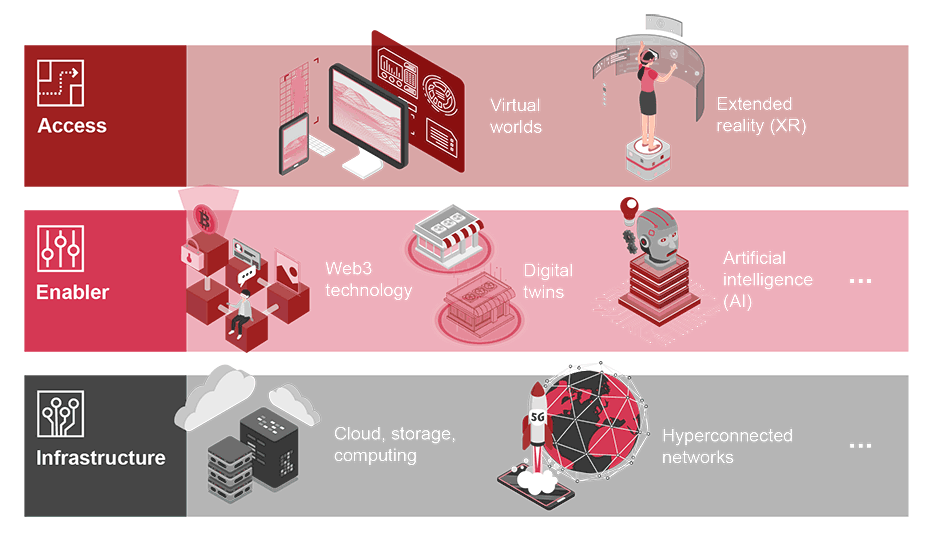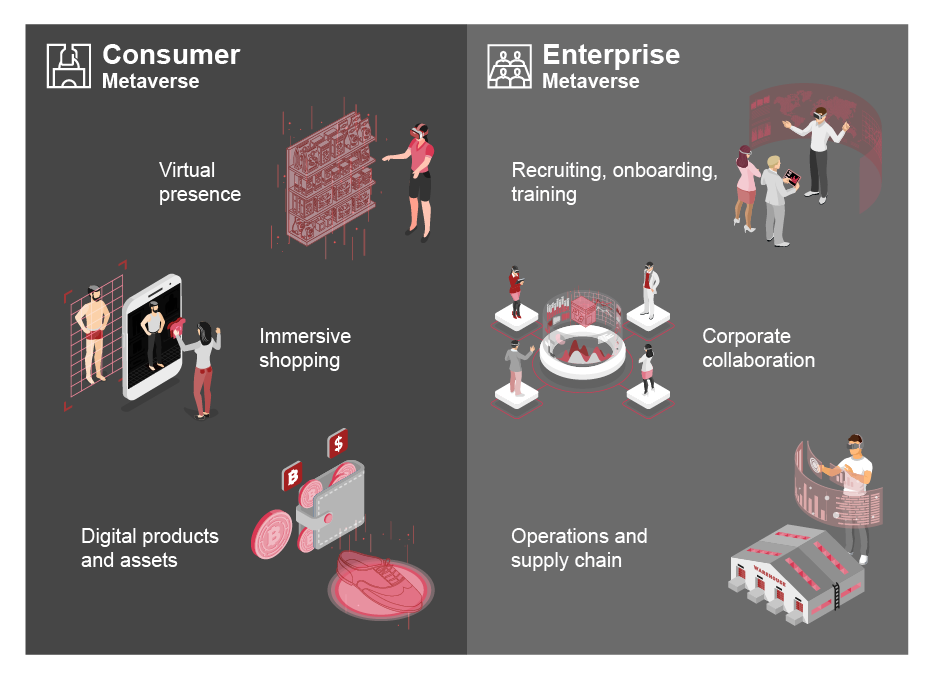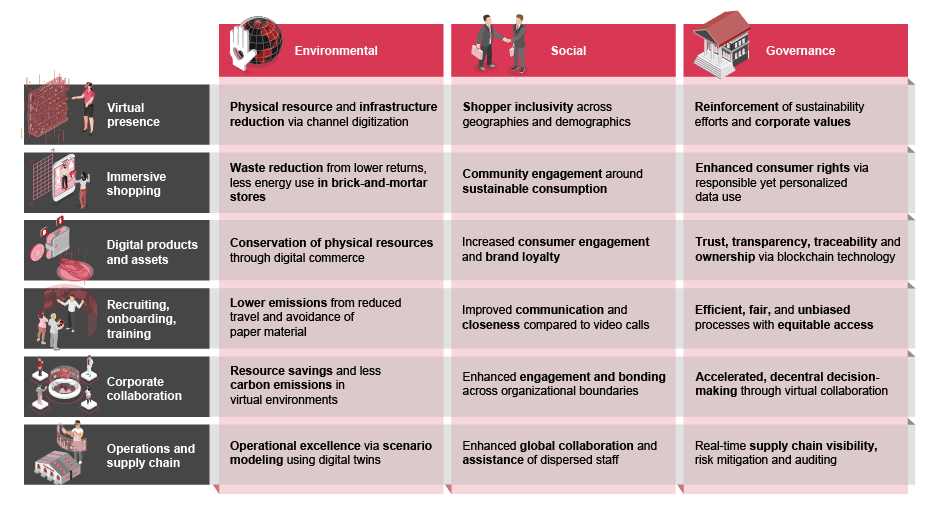Introduction
In recent years, the metaverse has captured considerable attention, notably among consumer goods brands and retailers such as Adidas, Nestlé, Schwarz Group, Walmart, and LVMH, who have ventured into virtual world experiences. Besides customer-facing use cases, some of these companies have additionally explored internal applications, utilizing the metaverse for workforce onboarding, training and collaboration. As this article will show, such innovative applications not only redefine consumer engagement and ways of working but also align with ESG (Environmental, Social, and Governance) objectives, emphasizing a commitment to sustainable practices.
The hype around the metaverse became substantial when Facebook changed its company name to Meta in late 2021 to reflect the future focus on associated technologies. However, Meta has since reported increasing losses in its metaverse-related division, Reality Labs. In 2023, the metaverse then found itself overshadowed by the rising prominence of one of its underlying technologies, artificial intelligence, and in particular Generative AI. Meanwhile, Apple's notable omission of the term "Metaverse" during its keynote on the Vision Pro Headset have prompted some pundits to prematurely declare the metaverse dead.
We believe this view is short-sighted. Certainly, the hype has cooled down with brands and retailers facing increasing economic pressures causing them to halt investments and focus on streamlining operations instead. At the same time, these companies are looking for innovative ways to advance sustainable and ethical business practices that align with their broader ESG agendas. In our view, the metaverse can provide just the right tools to address these challenges.
This article offers a brief overview of the metaverse and its foundational components, presents practical use cases from the retail industry, and assesses their potential impact on companies’ ESG objectives.
Metaverse building blocks
Building on its roots in gaming, the metaverse’s development remains evolutionary, and presently, no universally acknowledged definition exists. Within PwC and Strategy&, we prefer to conceptualize the metaverse as virtual or digitally overlayed 3D environments that can be accessed with avatars, allow for interactions and experiences, enable continuity of identity, objects and digital asset ownership, and increasingly integrate with the physical world.
Manifestations of a metaverse can come both in the form of open community-driven platforms (i.e., decentralized) or via private custom worlds often controlled by a single party. The metaverse is predicted to experience staggering growth resulting in a multi-billion dollar opportunity by the 2030s along hardware (e.g., access devices), software (e.g., platforms), and services (e.g., experiences, advisory, support). The retail industry takes a significant share of the overall addressable market, particularly driven by the prospects of e-commerce.
Importantly, the metaverse is not a standalone technology. Its growth is underpinned by the convergence of pivotal building blocks, which collectively define its expansive nature. In the dynamic realm of the metaverse, sustainability and innovation converge within three essential layers - access, enabler, and infrastructure - each comprising several building blocks (see Exhibit 1).

Exhibit 1: Metaverse layers and building blocks (non-exhaustive)
For more comprehensive introductions (A metaverse that works, Demystifying the metaverse) and current metaverse predictions, we refer to our existing articles within the global PwC network.
The impending integration of its technological facets solidifies the metaverse as a lasting phenomenon. The paramount question for brands and retailers then becomes: What’s their strategic stance toward the emerging opportunity, especially in light of a growing emphasis on sustainable business practices and broader ESG objectives?
The metaverse as an ESG opportunity for brands and retailers
To understand potential metaverse use cases for brands and retailers and evaluate how they contribute to sustainable, social, and ethical practices, we differentiate the two types of user groups that are typically addressed in the consumer and enterprise metaverse (see Exhibit 2). As the naming indicates, the former is associated with consumer-facing use cases where users can experience and immerse themselves in virtual worlds to interact with their favorite brands, participate in virtual shopping events and leverage digital products and assets. The latter describes a version of the metaverse that is mostly employed for company-internal use cases, allowing employees to meet and collaborate in virtual environments, receive training and education or use digital twins to simulate and optimize outcomes along the retail industry’s value chain. Note that use case categories may overlap as boundaries between them are blurring.

Exhibit 2: Use case categories in the consumer and enterprise metaverse (selection)
Virtual presence
This category comprises use cases allowing consumers to experience and interact with a brand and its corporate identity in social environments (such as today’s leading virtual gaming platforms). Retail companies (incl. fashion, lifestyle, wholesalers, grocers and CPGs) have multiple options to shape social and immersive experiences, e.g. by leveraging gamification in virtual worlds or hosting brand-specific events on respective platforms. In the long run, we expect the metaverse to become an increasingly important channel to reach relevant target groups (e.g. generations Z and Alpha) and strengthen consumers' brand loyalty (incl. via Web3 technology; see Digital products and assets).
ESG impact
Granting global access, the (public) metaverse can enable brands and retailers to create deep, emotional, and authentic experiences for a broad and diverse range of consumers. Metaverse based virtual presence and thus increasingly digitized marketing channels can curb the resource consumption of traditional channels such as print media. By curating virtual events and edutainment opportunities, the metaverse empowers brands to reinforce corporate values, brand identity, consumer awareness and transparency – for instance, via (gamified) content and quests on sustainability agendas including environmentally-friendly products, packaging, and services. Social interaction within these virtual environments is actively encouraged. Individuals can craft personal avatars and participate irrespective of geographical location, social background, age, or gender.
Examples
- At CES 2021 and 2022, Procter & Gamble unveiled LifeLab and BeautySphere, immersive virtual worlds that allowed visitors to navigate through a multitude of interactive zones featuring P&G brands and products while educating consumers about P&G's sustainability efforts (e.g., ingredients).
- To establish a virtual presence, Schwarz Group’s Kaufland has purchased an island in Nintendo's game Animal Crossing and aptly named it "Kauf Island". In this gamified and interactive experience, visitors can explore the surroundings and gain insights into Kaufland's sustainability strategy.
Immersive shopping
This category describes the next evolutionary phase of shopping, by leveraging building blocks of the metaverse to create more convincing and convenient shopping opportunities. Use cases include 3D try-on of physical goods in fully virtual showrooms (via VR) and the use of AR to project digital replicas of goods onto the own body (in case of fashion) or inside the own home (e.g., furniture). These use cases can be augmented by virtual assistants as well as advantages of e-commerce such as embedded digital payment and convenient fulfillment.
ESG impact
While no shopping is the most sustainable (yet - let’s face it - unrealistic) option, immersive shopping offers enormous potential to improve environmental ambitions. Brands and retailers can showcase products without requiring flamboyant packaging. Upfront fitting may reduce product returns and thus tackle one of the biggest challenges in e-commerce. As a result, waste avoidance may save resources and boost retailers’ tight margins (especially in market segments like fashion where up to 60% of original item sales prices are lost due to high return rates, also causing landfill waste and CO2 emissions). In addition, immersive shopping can make second-hand marketplaces such as eBay even more tangible and facilitate community exchange around circular economy and sustainable consumption. As consumers have an attractive remote shopping opportunity, commuting to downtown flagship stores might decrease, and so would the need for physical stores and associated energy consumption. This vision, admittedly, lies in a distant future where immersive shopping becomes the norm.
Examples
- Wholesale giant Walmart acquired the immersive shopping startup Zeekit to enable customers to virtually try on fashion products. Returns were reduced by 36% following the introduction of virtual fitting rooms.
- H&M launched the Loooptopia Experience on Roblox, an immersive gaming adventure focused on sustainability. Players can collect coins to create unique digital garments. This initiative builds on H&M's previous collaborations, like the "phygital" collection, featuring a blend of digital fashion accessible via AR and tangible garments available in physical stores.
Digital products and assets
Offering purely digital products or assets in the metaverse presents an exciting economic and social opportunity for brands. Digital products can be a data-based copy (or replica) of an existing physical good (e.g., virtual shoes on an avatar), ownership of which can be stored on a blockchain, or an exclusively digital asset or collectible (e.g., an NFT) enhancing customer engagement and creating new avenues for revenue generation. These assets can be leveraged as a status symbol in virtual worlds or to grant access to exclusive services, events, and communities. Using web3 technology in loyalty programs (issuing NFTs and redeemable tokens) could allow retailers to incentivize “positive” consumer behavior - such as purchasing sustainable packaging products, shopping from local merchants or buying organic goods. Beyond enhancing the consumer experience, Web3 technology may also improve consumer good companies’ supply chain performance.
ESG impact
Digital products in a blockchain-enabled metaverse may enhance trust, accountability and transparency in terms of ownership and origin of assets, secure transactions and data privacy. However, computing intense consensus algorithms may have a negative environmental footprint. Use of Web3 technology also has significant potential to create participative governance mechanisms (e.g., decentral autonomous organizations; DAO). Worldwide access improves inclusion for consumers and creators, e.g. for trading of digital products. An increased focus on commerce of digital goods can help conserve physical resources and address typical shortcomings of fast fashion (e.g., by eliminating certain needs for production, storage or shipping of goods).
Examples
- Fashion brands like H&M or Tommy Hilfiger collaborate with digital fashion marketplace DRESSX to launch purely digital fashion. These items can be worn in the metaverse or projected via AR onto buyers’ bodies to show off looks on social media.
- In China, Pepsi unveiled its metaverse “Play Pepsi Concept Store”. Users can earn “Pepsi Zero Sugar Coins”, a digital token, by completing challenges in the metaverse and use them to enter a lucky draw game rewarding them with vouchers for real life prizes such as Pepsi-branded articles.
- US theater chain AMC offered Spider-Man NFTs to movie ticket-buying members of its loyalty program. The virtual assets were key in also driving physical revenues, generating the second-highest one-day ticket sales in AMC’s history.
Recruiting, onboarding, training
Within the realm of enterprise metaverse solutions, retail companies can employ an expansive arena fostering idea sharing, immersive interactivity, and the transfer of intricate knowledge or concepts. Corporate functions, including Learning and Development or Human Resources, can leverage virtual environments as a dynamic channel for talent acquisition, streamlining employee onboarding processes, and offering immersive training experiences that bridge the gap between theory and real-world application while up to 4x increasing learning efficiency and focus.
ESG impact
By embracing virtual environments for onboarding and training, brands and retailers reduce their carbon footprint associated with traditional in-person training and related travel, aligning with environmental sustainability goals. Virtually-assisted learning opportunities enhance social aspects by promoting inclusivity, accessibility, and emotional connection to content and e-learning peers. Individuals with diverse backgrounds and needs can participate in these immersive experiences regardless of physical location and mobility. Moreover, by investing in cutting-edge digital learning, companies demonstrate a commitment to governance practices that foster innovation and efficiency.
Examples
- Companies like Adidas, Carlsberg, and Unilever partner with virtual training platform Gemba to train employees in VR.
- Chocolate maker Mondelez piloted virtual onboarding in India, allowing newly recruited employees to tour digital versions of the company’s manufacturing facilities, innovation centers, and corporate offices while meeting colleagues virtually.
- Similarly, at PwC we use our Global Metaverse Campus as well as the Virtual Spaces platform to collaborate internally and with our clients and recently also introduced an option for VR-based employee recruiting.
Corporate collaboration
An exciting prospect of the metaverse is overcoming limits of current remote work that inhibit creativity and agile project execution. Immersive virtual innovation hubs may not only foster collaboration within organizations but also with external partners (such as suppliers, innovators, academia and environmental experts) and even customers. In that sense, this use case blurs into the consumer metaverse, as it provides an opportunity to engage customers by strengthening collaboration in open ecosystems (e.g., preference sharing, co-creation of innovative products and solutions to address environmental challenges).
ESG impact
Increased virtual collaboration via users’ digital avatars diminishes the need for business travel to physical meetings - a significant measure to help reduce one’s carbon footprint. Also, product development may become more targeted when brands (e.g., fashion, CPGs) gather supplier and consumer feedback on virtual product concepts. Gauging preferences and making iterative improvements without the need for physical prototypes minimizes resource consumption and waste. Beyond environmental aspects, the metaverse may foster community engagement by immersing experts and consumers in joint problem-solving across geographical, functional and even organizational silos.
Examples
- During the pandemic, Nestlé virtualized shelf space layouts in the metaverse and discussed them together with retail partners using VR headsets - effectively cutting travel costs and reducing environmental impact by removing the need for physical presence in a store when making shelving decisions.
- Companies and organizations like Nike, TEDx or even the United Nations use metaverse platforms to host and collaborate in virtual and hybrid events.
- In a collaborative initiative the Ministry of Internal Affairs in Lower Saxony, Germany, the University of Münster, and PwC, developed a VR pilot. This study yielded profound insights into the effectiveness of VR as a collaborative tool, surpassing traditional video conferencing solutions. The results indicated an 11% increase in satisfaction with workshop outcomes, a significant 16% enhancement in communication, and an impressive 58% stronger sense of camaraderie among colleagues when working remotely.
Operations and supply chain
Sometimes referred to as the “industrial metaverse”, this use case comprises the virtualization of physical assets or parts of the entire supply chain (such as warehouse and production facilities), enabled via digital twins and accessed by XR technology. This use case enhances virtual collaboration of globally dispersed staff, for instance, via remote assistance. It also enables real-time data analysis for assets and processes via digital overlays and facilitates simulations and scenario planning for strategy development, allowing companies to optimize their operations based on gathered insights.
ESG impact
The metaverse can facilitate the optimization of supply chains and operations by creating virtual simulations and models, enabling brands and retailers to analyze and improve logistics, transportation routes and inventory management processes. Optimized processes can prevent issues and rework upfront and reduce energy consumption and emissions. Real-time controlling can also optimize process efficiency to help minimize energy consumption and save scarce resources.
For instance, catastrophe modeling within the metaverse can simulate scenarios like flooding and wildfires around production facilities or assess the impact of unmet Paris Agreement climate goals. This proactive approach, encouraged by new ESG regulations such as the EU Taxonomy, can enable businesses to address supply chain challenges and secure funding from the capital market by aligning with climate catastrophe prevention efforts.
Examples
- Kraft Heinz teamed up with Microsoft to map out supply lines virtually and create a digital twin on the Azure Cloud. This is used to simulate product runs in advance and spot any issues that might arise.
- Luxury giant LVMH announced a partnership with Epic Games to build digital twins of its fashion products. Their designs can now be tested in the metaverse before they are put into production and tools are deployed to create interactive and immersive fashion show experiences.

Exhibit 3: Summary of positive ESG impact potential along use case categories (selection)
Approaching the metaverse x ESG opportunity
Curious how you may dive in and explore concrete opportunities? Below, we outline tangible steps for brands and retailers to engage in metaverse-related activities with a focus on sustainable outcomes:
- 1Align your goals strategically: Assess how the metaverse (or its underlying building blocks) can help deliver against your most important ESG objectives.
- 2Test the waters: Identify a few most promising, low-cost and low-effort use cases to start incrementally – for instance, by experimenting with one of the metaverse’s building blocks (e.g., applying Web3 technology in your existing loyalty programs) or by exploring one of the six use case categories we outlined in this article (e.g., virtual world presence to inform customers about your sustainability efforts or experiment with VR-based training).
- 3Foster cross-functional buy-in: Collaborate across organizational silos by engaging teams with diverse perspectives, for instance, strategy, customer interaction, ESG and technology departments.
- 4Ensure organizational readiness: Hire or use the existing potential of your digital natives’ or Gen Z employees with sound understanding of basic metaverse concepts and a strong sense of relatability to ESG principles.
Importantly, managing trust and risks from the outset and staying true to your purpose and brand messaging is imperative across your omni-channel offering in physical and digital worlds. With you in the metaverse, our global community of solvers can help create sustainable value for your enterprise and the broader society.
Florian Voigt and Julia Lorey also contributed to this article.






